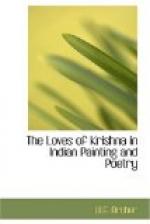rather than the Raja himself who worshipped Krishna.
Sometimes it was not the ruling family but members
of the merchant community who sponsored the artists
and, occasionally, it was even a pious lady or devout
princess who served as patron. Such differences
of stimulus had vital effects and, as a consequence,
while the cult of Krishna came increasingly to enthrall
the northern half of India, its expression in art
was the reverse of neat and orderly. Where a
patron was so imbued with love for Krishna that adoration
of the cowherd lover preceded all, the intensity of
his feeling itself evoked a new style. There
then resulted the Indian equivalent of pictures by
El Greco, Grunewald or Altdorfer—paintings
in which the artist’s own religious emotions
were the direct occasion of a new manner. In other
cases, the patron might adhere to Krishna, pay him
nominal respect or take a moderate pleasure in his
story but not evince a burning enthusiasm. In
such cases, paintings of Krishna would still be produced
but the style would merely repeat existing conventions.
The pictures which resulted would then resemble German
paintings of the Danube or Cologne schools—pictures
in which the artist applied an already mature style
to a religious theme but did not originate a fresh
mode of expression. Whether the greatest art
resulted from the first or second method was problematical
for the outcome depended as much on the nature of the
styles as on the artist’s powers. In considering
Indian pictures of Krishna, then, we must be prepared
for sudden fluctuations in expression and abrupt differences
of style and quality. Adoration of Krishna was
to prove one of the most vital elements in village
and courtly life. It was to capture the imagination
of Rajput princes and to lead to some of the most intimate
revelations of the Indian mind. Yet in art its
expression was to hover between the crude and the
sensitive, the savage and the exquisite. It was
to stimulate some of the most delicate Indian pictures
ever painted and, at the same time, some of the most
forceful.
The first pictures of Krishna to be painted in India
fall within this second category. In about 1450,
one version of the Gita Govinda and two of
the Balagopala Stuti were produced in Western
India.[67] They were doubtless made for middle-class
patrons and were executed in Western India for one
important reason. Dwarka, the scene of Krishna’s
life as a prince, and Prabhasa, the scene of the final
slaughter, were both in Western India. Both had
already become centres of pilgrimage and although Jayadeva
had written his great poem far to the East, on the
other side of India, pilgrims had brought copies with
them while journeying from Bengal on visits to the
sites. The Gita Govinda of Jayadeva had
become in fact as much a Western Indian text as the
Balagopala Stuti of Bilvamangala. With
manuscript illustrations being already produced in
Western India—but not, so far as we know,




